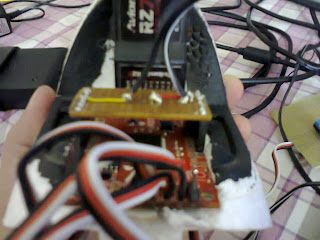We realized that by merely doing the flag int_flightplan 1 in telemetry.c will not direct our program in Return To Land Mode. We discovered in the programming that RTL mode can only be achieved when two conditions are met:
- Program/drone is in Auto-Pilot Mode, for this we need our gps to be locked &
- failSafePulses or the pulses coming from the transmitter are 0 i.e. we have lost the radio signal
This can be seen from the following program in states.c file:
/////// Come home state, entered when the radio signal is lost, and gps is locked.
void ent_returnS()
{
flags._.GPS_steering = 1 ;
flags._.pitch_feedback = 1 ;
flags._.altitude_hold_throttle = (ALTITUDEHOLD_WAYPOINT == AH_FULL) ;
flags._.altitude_hold_pitch = (ALTITUDEHOLD_WAYPOINT == AH_FULL || ALTITUDEHOLD_WAYPOINT == AH_PITCH_ONLY) ;
#if ( FAILSAFE_TYPE == FAILSAFE_RTL )
init_flightplan( 1 ) ;
#elif ( FAILSAFE_TYPE == FAILSAFE_MAIN_FLIGHTPLAN )
if ( stateS != &waypointS )
{
init_flightplan( 0 ) ; // Only reset non-rtl waypoints if not already following waypoints
}
The condition to control the failSafePulses is mentioned in the background.c file:
if ( ( failSafePulses == 0 ) || ( noisePulses > MAX_NOISE_RATE ) )
{
if (udb_flags._.radio_on == 1) {
udb_flags._.radio_on = 0 ;
udb_callback_radio_did_turn_off() ;
}
LED_GREEN = LED_OFF ;
noisePulses = 0 ; // reset count of noise pulses
}
else
{
udb_flags._.radio_on = 1 ;
LED_GREEN = LED_ON ;
}
failSafePulses = 0 ;
}
Mode is mentioned in telemetry.c file and can be controlled from the receiver:
void serial_output_8hz( void )
{
uint16_t mode ;
struct relative2D matrix_accum ;
union longbbbb accum ;
int16_t desired_dir_deg ; // desired_dir converted to a bearing (0-360)
int32_t earth_pitch ; // pitch in binary angles ( 0-255 is 360 degreres)
int32_t earth_roll ; // roll of the plane with respect to earth frame
//int32_t earth_yaw ; // yaw with respect to earth frame
accum.WW = ( desired_dir * BYTECIR_TO_DEGREE ) + 32768 ;
desired_dir_deg = accum._.W1 - 90 ; // "Convert UAV DevBoad Earth" to Compass Bearing
if ( desired_dir_deg < 0 ) desired_dir_deg += 360 ;
if (flags._.GPS_steering == 0 && flags._.pitch_feedback == 0)
mode = 1 ;
else if (flags._.GPS_steering == 0 && flags._.pitch_feedback == 1)
mode = 2 ;
else if (flags._.GPS_steering == 1 && flags._.pitch_feedback == 1 && udb_flags._.radio_on == 1)
mode = 3 ;
else if (flags._.GPS_steering == 1 && flags._.pitch_feedback == 1 && udb_flags._.radio_on == 0)
mode = 0 ;
else
mode = 99 ; // Unknown
Hence to meet the above two conditions we created a flag BATT_FLAG which we defined in telemetry.c and declared as extern in defines.h file. When BATT_FLAG is set to 1 (in telemetry.c file) the int_flightplan will become 0 (in background.c file) and thus enable out RTL Mode.
In telemetry.c file:
#define batt_min_value 16000
int BATT_FLAG =0;
if((udb_analogInputs[0].value<batt_min_value) && (mode = =3)) // if battery value goes below 16000 and is in Auto-Pilot Mode
{
BATT_FLAG =1;
}
//////////////////////////////////////////////////////
if(mode<3) // if in Manual or Stabilized Mode then will never make BATT_FLAG 1 and int_flightplan 0
{
BATT_FLAG =0;
}
In background.c file:
// check to see if at least one valid pulse has been received,
// and also that the noise rate has not been exceeded
if(BATT_FLAG = =1)
{
failSafePulses =0;
}
if ( ( failSafePulses = = 0 ) || ( noisePulses > MAX_NOISE_RATE ) )
{
if (udb_flags._.radio_on == 1) {
udb_flags._.radio_on = 0 ;
udb_callback_radio_did_turn_off() ;
}
LED_GREEN = LED_OFF ;
noisePulses = 0 ; // reset count of noise pulses
}
else
{
udb_flags._.radio_on = 1 ;
LED_GREEN = LED_ON ;
}
failSafePulses = 0 ;
}
Here if we change from Auto-Pilot Mode to any other Mode then our BATT_FLAG will become 0 and our failSafePulses will start receiving real time signals from the transmitter on the drone.
How we monitored our changes, I will mention that in my next post.


































